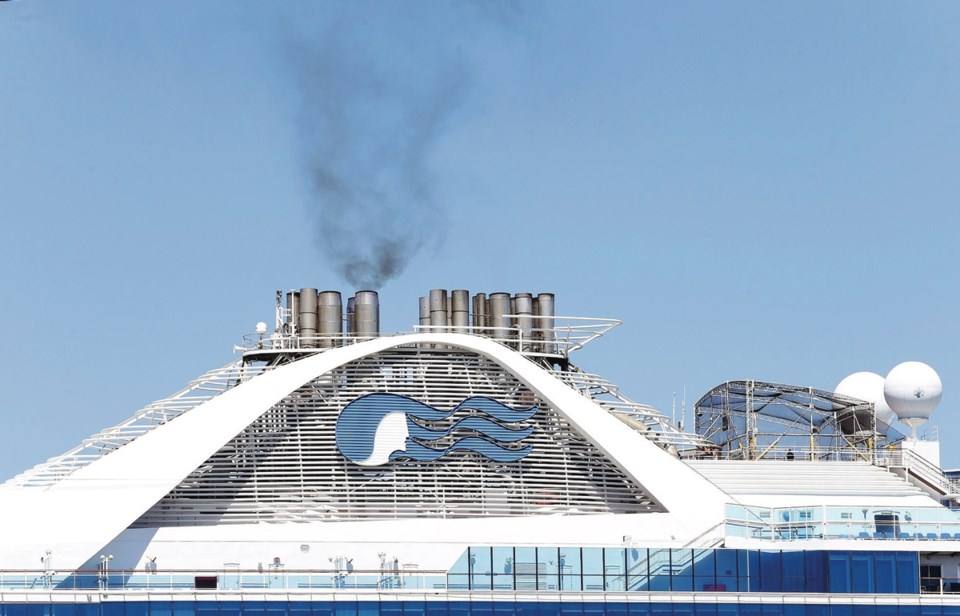Sulphur-dioxide emission issues may be dwindling in James Bay, but it’s by no means clear sailing for the city’s cruise ship industry, according to the James Bay Neighbourhood Association.
A report released Wednesday by the B.C. Ministry of Environment suggests sulphur content regulation for fuels used by cruise ships, and use of technologies to reduce emissions have been effective in reducing ambient levels of sulphur dioxide coming from cruise ships docking at Victoria.
But the measures have not stopped all emissions, said Marg Gardiner, president of the James Bay Neighbourhood Association. “There’s other emissions other than sulphur dioxide coming out of that [cruise ship smoke] stack,” said Gardiner. “This report is good news, but it’s old news. And while it’s the end of sulphur dioxide, it’s not really the end of pollution from the ships.”
Gardiner said her group knew sulphur dioxide readings were dropping because it has been monitoring readouts daily over the last year. “But there’s still an emission issue, whether it’s a health issue or not we don’t know, and there’s still particulate matter that’s an issue,” she said.
She said the group has fielded more complaints this year than in the last two over cruise ship emissions, though that may be a result of new people moving into the area, rather than simply the increase in cruise ship activity.
There’s always room for more testing to be done, she said.
The Ministry of Environment did not return requests for comment Wednesday.
The report, prepared by University of Victoria geographer Eleanor Setton and funded by the ministry and the Greater Victoria Harbour Authority, compared levels of sulphur dioxide in 2014 and 2015 with levels measured in 2009 before new regulations were in place. It found that air quality guidelines were “infrequently exceeded at the air quality monitoring station in James Bay and at the regional air quality monitoring station located at Topaz Avenue — approximately 4.5 kilometres downwind of the cruise ship terminal.”
The report noted that despite an increased number of cruise ship visits over the last two years (last year there were 227 and there were 206 in 2014) that in general “more than 99 per cent of hours on record at both stations” fell within Island Health’s risk category of “good.”
It said in 2014 there were 11 hours in James Bay when there were sulphur-dioxide levels in Island Health’s “moderate” category and three in the “unhealthy for sensitive groups” category. All hours in 2015 were in Island Health’s “good” category at both stations.
It also recorded that sulphur dioxide levels did not exceed the World Health Organization’s 10-minute average guideline at either station in 2014 or 2015, and WHO’s daily (24-hour average) guideline was exceeded twice at each station in 2014, but not at any time in 2015.
“With all of the improvements made over the years with the emission control area, lower sulphur fuel requirements, scrubber technology the cruise lines have invested in we are not surprised there has been a trend downward in the readings,” said harbour authority chief operating officer Sonterra Ross.
Ross said initiatives undertaken by the harbour authority such as financial incentives for ground transportation companies to use newer and cleaner buses, promoting walking when passengers arrive, moving pedicabs and bike rentals close to where passengers disembark and moving the ground transportation staging areas closer to the water at Ogden Point all made a difference in air quality.
Ross said the $3 fee per passenger for transport companies using buses that are older than 2005 has made a big difference.
Later this year the harbour authority will push a pilot project with one bus company to run an electric double-decker bus for cruise ship passengers.
Gardiner said there is still plenty more that could be done to reduce pollution. She cited changing schedules so ships would have to stay longer and use onshore power instead of burning diesel and the use of more LNG-powered cruise ships.



